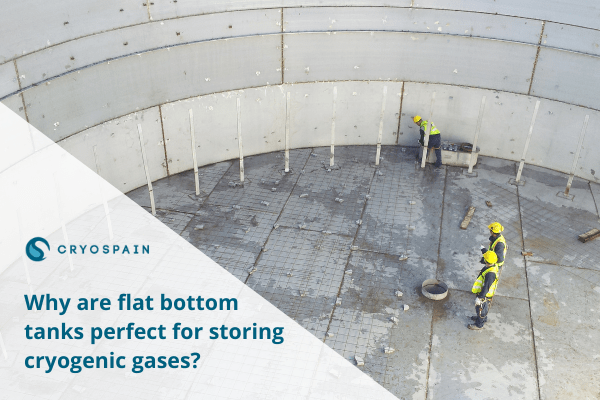Flat bottom tanks represent an efficient storage system for a number of substances, including cryogenics and liquefied gases.
As more and more businesses and industries are dependent on optimal storage of substances in order to have immediate access to them, flat bottom tanks are increasingly demanded.
What exactly are flat bottom tanks and what are their possibilities and advantages? We take a close look at this storage option and a few successful projects by Cryospain.
Flat-bottom tanks features
Flat bottom tanks are storage structures that present a round cylinder shape and a flat base. These systems can help preserve and store a wide array of substances and can thus be fabricated to specifically meet each substance and business needs.
Among their key advantages, flat bottom tanks are known to be quick to install, easily manipulated and transported and to require a simpler structure than other alternatives (such as cone tanks) because no stand is needed for their installation. Even if they don’t use a stand, they can be installed on irregular terrain, such as gravel.
Some of their features include:
- Materials: the most common materials include fiberglass, polyethylene, carbon steel and stainless steel.
- In the case of cryogenic storage tank design, their thermal insulation is key to preserving substances. This is typically achieved through double-wall steel structures, as well as diverse insulation materials, from cellular glass, to rockwool and expanded perlite.
- They come in different sizes according to each businesses’ needs
- Double bottom tanks can be designed if the project needs it (for instance, if the stored substance is too heavy and puts a big stress on the tank.
- A number of regulations seek to standardize the design and manufacture of flat bottom tanks. These include some for mechanical and seismic design (API620, API650, ASME, EN14620, EN14015, EUROCODE); external access (EN ISO14122-1/3, OSHA 1910.23/24) and other regulations such as EIGA/CGA/127/13/E and NFPA 59A.
Flat-bottom tanks vs cone tanks
Cone tanks represent perhaps the most well-known alternative to flat-bottom tanks. The main difference between these two storage options is that cone tanks present a conical bottom. Thus, their installation requires a purpose-built stand.
The choice between both types of tanks will depend on each company’s needs, as well as their budget and the type of substance to be stored:
- Because cone tanks need additional structure (their stand), they’re usually more expensive and more difficult to transport, manage and install.
- Cone tanks are emptied quickly and easily and facilitate complete drainage.
What is stored in flat bottom tanks?
Flat bottom tanks can store a wide array of substances: from liquids like water to industrial chemicals.
These solutions are particularly fit for the storage of cryogenics, which must be stored at very low temperatures to maintain their properties.
These substances present specific cryogenic storage tank design requirements in terms of materials and size. For instance, they’re typically built with durable materials that also present a low thermal conductivity. In terms of sizes, these are the most common:
- Liquid air gases (LIN, LOX, LAR) will present a capacity from 500 to 15,000 m³
- LNG, LPG, and liquid ethylene require a capacity from 1,000 to 30,000 m³.
You may like: Insulated vessels, the technology that adapts to your needs
Discover some of the Cyrospain’s projects
At Cryospain we design and manufacture efficient custom flat-bottom cryogenic tanks according to our clients’ needs while also meeting international and local regulations.
No two projects are identical and we offer tailored solutions for our cryogenic tank design, which typically consists of the following stages:
- Design, applying the latest software technology and our expert engineering team’s know-how in order to generate the best possible design. This is the moment where we ensure the maximum precision in the development of detailed drawings, simulations, calculations. At this point, we also incorporate the necessary requirements to comply with international and national quality and safety standards.
- Construction, ensuring coordination between our engineering and production teams and the strictest quality controls. Finishing the tanks also means applying testing protocols in order to guarantee their safety.
- On-site Implementation and post-sale maintenance programs.
Flat-bottom cryogenic tanks for LIN and LOX storage in the Czech Republic
Our flat bottom tanks for LIN and LOX storage involved a collaboration between our team of engineers and draughtsmen in order to design and implement 2500 m3 LOX LOX and 2000m3 LIN tanks, substances needed for our client’s modern steel mill.
Both projects present a design temperature of -196 ºC and were designed to comply with the EN 14620 standard, in compliance with industry regulations.
Flat bottom tanks for LOX in Alabama
As part of Cryospain’s growing presence in the USA, we built a 2,200m³ LOX tank. This time, the tank was built on an elevated platform several meters high, for which our engineers were in charge of creating a tailor-made ladder system.
The tank will provide a petrochemical plant in Calvert (Alabama) the access they need for this cryogenic substance.
Cryogenic storage tanks in Italy and Czechia
The design and manufacture of two cryogenic flat-bottom tanks in Italy and the Czech Republic speaks of Cryospain’s capacity to generate customized solutions according to our clients’ needs.
The Czech case presents a capacity of 2500 m3 and is approximately 20 metres high, while we built a smaller solution for our Italian clients, that required a storage solution of 1500 m3 and a height of 16 metres.
Want to learn more about our custom-made flat bottom tanks and see if they’re the optimal storage options for your company? Get in touch with us and our team of experts will help you analyze your design and manufacture needs.










 Contacte-nos
Contacte-nos